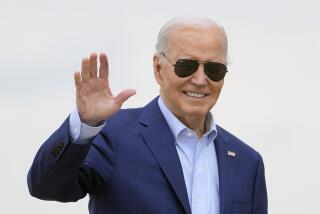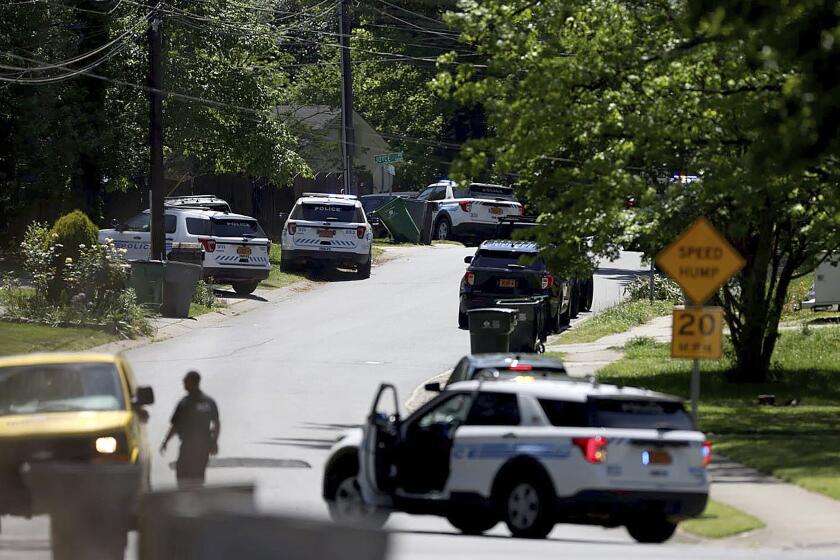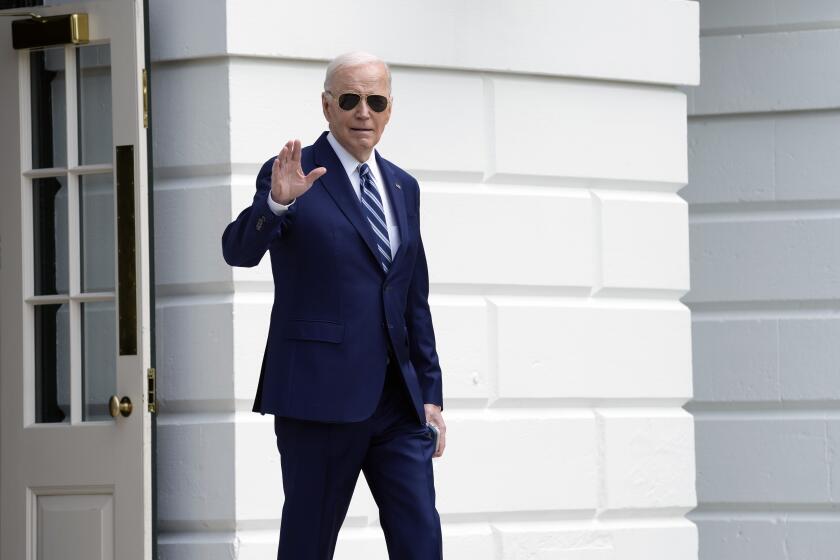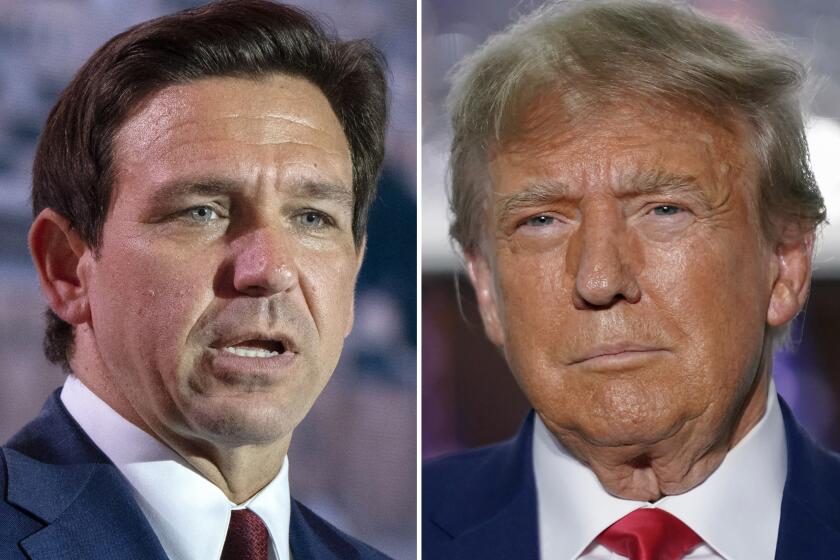An Island on the Verge
Tommy Remengesau Jr., the president of this tiny Pacific nation, will never forget the day four decades ago when he went sailing on his bamboo raft and returned with more fish than his family could eat.
He figured his parents would be pleased. Instead, his father hit him on the head and lectured him on the principles of conservation.
“I thought I was a hero,” the president recalled. “But my father said, ‘What are you going to do with the rest of this fish?’ I never forgot that lesson.”
It’s the kind of story told by many Palauans to explain the tradition of preservation that has made their remote Micronesian country a leader in ecological protection in the Pacific.
Now, Remengesau, 50, and his country of more than 300 islands face an environmental challenge that goes way beyond a boy catching too many fish.
This year, the U.S. Army Corps of Engineers is scheduled to complete a long-delayed, 53-mile road around the country’s largest island, Babelthuap. The highway will open the shoreline to potential development on a scale unseen in Palau’s brief history as an independent nation.
Palau also faces an economic crisis in three years, when the U.S. is to cut off foreign aid that totals 40% of the country’s budget. The loss is certain to cause financial hardship, and there is a sense of urgency here to find new sources of income. Many Palauans hope the transition can be made without compromising the country’s pristine character.
“Palau is going to have a lot of changes, and there is going to be a lot of pressure to develop,” said Noah Idechong, a member of the legislature and a prominent environmental activist. “Palau is going to have to learn to say no.”
The former U.S. territory, granted independence in 1994, is renowned for the clarity of its water and the diversity of its coral reefs. One of its prized national assets and natural oddities is a lake with more than 1 million stingless jellyfish. Its noted Rock Islands have long lured divers and naturalists from around the world.
But these days, with the road coming, Palau also is attracting international hotel, casino and golf course developers, who have begun acquiring local partners and making deals.
Idechong, who was awarded the Goldman Environmental Prize in 1995 for his work protecting marine life, worries that economic pressure and the lack of a national land-use plan will lead to reckless development on Babelthuap that could endanger the reefs by destroying mangroves and causing sedimentation.
Others complain that the country is giving too much say over its future to foreign businesspeople who care little about preserving Palau’s traditions. A 157-room hotel opened last year by a Japanese chain on the capital island of Koror is staffed almost exclusively by low-paid foreign workers. Guests can spend their entire holiday in Palau without meeting a Palauan.
“In 10 years, without proper planning, we will have flesh and blood but Palau will be a ghost race,” said Duane Hideo, former governor of the state of Ngchesar. “Some of the investors are very aggressive, especially the ones that come from Asia -- ‘I want this. I want that.’ ”
Today, two-thirds of the country’s economy is based on tourism. Palau is so oriented toward visitors that even the jail in Koror has a gift shop where inmates sell traditional wood carvings.
About 4,600 miles southwest of Hawaii, Palau is one of the world’s smallest countries, with a land mass roughly 2 1/2 times that of Washington, D.C. It is also one of the newest: After nearly 40 years as a U.S. protectorate, it now is the world’s second-youngest country, behind East Timor.
With a population of 20,300, Palau is so low-key that it has only two stoplights. Both are switched off because motorists complained that they impeded traffic flow.
All told, there are fewer than 20,000 Palauans in the world. About 13,000 live in Palau, with most of the rest on Guam and the U.S. mainland. Tribal ties remain strong in business and politics; the candidate with the largest number of relatives usually wins.
The rest of Palau’s population consists of foreign workers, mainly from the Philippines and China, who are employed in the tourist industry and make up nearly three-quarters of the labor force.
Though Pacific islands are often marketed to tourists as paradise, they can be tough places for natives to make a living. Many island nations have few natural resources, a small labor pool and exorbitant prices for imported goods.
With the help of U.S. subsidies, Palau has maintained a per capita income of $6,870, one of the highest in the Pacific. Its leaders hope the country won’t have to resort to the kind of questionable moneymaking activities adopted by some of its neighbors.
The Marshall Islands, Tonga and Kiribati, for example, have alarmed U.S. authorities by selling passports to foreigners. Vanuatu and Tuvalu have made handsome profits leasing their country telephone codes to sex talk providers. Tuvalu sold its Internet domain name (.tv) to a private company, as did Niue (.nu).
Tiny Nauru, one of the wealthiest Pacific nations until its phosphate reserves ran out, became notorious as a “tax haven” where banks allegedly laundered Russian mafia money. Later, desperate for cash, Nauru accepted $15 million from Australia to set up a detention center for 900 unwanted asylum seekers.
The Northern Mariana Islands, a U.S. territory, opened its doors to businesses that use cheap labor to produce “Made in America” clothing. At one point, the islands paid $6.7 million to the firm of lobbyist Jack Abramoff to seek U.S. concessions for the businesses -- critics call them sweatshops -- including exemption from the minimum wage.
Under the compact granting Palau independence, the U.S. agreed to give the country about $20 million a year for a 15-year period ending in 2009. In exchange, the United States retains until 2044 the option of establishing a military base in Palau -- although with large Air Force and Navy bases 800 miles away on Guam, it seems unlikely that will happen.
The Palau government is the main employer of natives, and they are likely to be hit the hardest when the U.S. subsidy ends and the government must slash its payroll.
As part of the independence pact, Washington agreed that the Army Corp of Engineers would build the road around Babelthuap, the second-largest island in Micronesia after Guam. The two-lane highway cuts through jungle and farms inland from the coast, connecting villages that have long been isolated.
The 12-year, $149-million undertaking is one of the corps’ biggest peacetime ventures outside the United States. Plagued by heavy rains, landslides and cost overruns, the project is six years behind schedule and nearly $30 million over budget.
“It was a very astute move on the part of the Palauans to get the U.S. to commit to building the road instead of just committing funds,” said Alex Morrison, the corps’ senior manager in Palau and overseer of the project. “It assured the construction of the road.”
The highway will more than triple the amount of paved road in Palau and allow the resettlement of much of Babelthuap, which has largely been abandoned for the ease of life in Koror, the most urbanized island.
“This opens a lot of land and a lot of possibilities,” Morrison said. “But Palauans are very well aware of the risk of the loss of the uniqueness and beauty of their country, and they will take steps to manage the development in ways that will accentuate rather than destroy their country.”
Perhaps so. But the new government center being built on Babelthuap may be a sign of things to come.
Rising incongruously above the jungle midway up the island is a grand new building with a dome modeled on the U.S. Capitol. The air-conditioned edifice, a monument to Palau’s democratic ideals, is visible for miles. Scheduled for occupancy when the Babelthuap road is finished, the $40-million structure is certain to spur a building boom in the area.
The dome may look out of place, but it is intended to symbolize Palau’s close ties to the U.S. and its commitment to democracy. Its construction was inspired by Raphael Ngirmang, a stocky, 27-year U.S. Marine Corps veteran who is now one of Palau’s two top tribal chiefs.
Critics say the capitol should have been built in traditional, open-air, Palauan style, but the chief defends the choice. “I want the world to know that Palau has a vision as large as any country,” said Ngirmang, 73, who is better known as High Chief Reklai.
“We feel the U.S. is a big brother,” added Ngirmang, a leading member of the president’s advisory council of chiefs. “Everything we do we follow the U.S. style. We are die-hard for the U.S.”
Indeed, Americans are liked here more than in much of the world. The United States is still celebrated for driving out the Japanese during World War II.
Palauans fly American flags on their cars on the Fourth of July. U.S. dollars are the currency, and Palau still uses its U.S. Zip Code. Americans can come here without a passport. Television broadcasts American sports, and U.S. sailors are welcomed during shore leave.
In its governing style, Palau blends tradition with U.S.-style democracy. The government -- the president and members of the legislature -- is elected. The chiefs, who rule in the villages, are chosen by the female elders. Many believe tribal traditions are why Palau has been so successful in conservation.
Soon after Palau gained independence, Idechong, then working as an environmental activist, invoked tribal customs to secure the country’s first bul, a marine area where fishing is banned by a local chief. Today, chiefs have designated 20 buls, protecting a coastal area as big as Miami and constituting an essential part of the country’s marine preservation program.
Palau has won praise for banning the practice of catching sharks and taking only their fins to sell in Asian markets for shark fin soup. President Remengesau set fire to a pile of confiscated fins to call attention to the ban.
But sometimes the laws fall short.
One glaring gap in Palau’s conservation ethic is the widespread sale of products made from the shells of endangered sea turtles. Environmentalists say efforts to limit the hunting of turtles have been blocked by members of Palau’s legislature who own souvenir shops and profit from the trade.
And despite mounting pressure to approve construction of beach resorts and golf courses, the legislature has yet to come up with a master plan for development. “We don’t have any land-use plans,” Idechong said. “We are very late.”
In particular, Idechong worries that the Babelthuap highway, new secondary roads and other construction could create more sediment flowing into the sea and put more stress on reefs that have not recovered from damage caused by higher ocean temperatures.
Palau suffered massive bleaching of its coral in 1998 when water temperatures rose dramatically, in what some see as a sign of global climate change. Near the surface, many reefs remain a wasteland. Scientists say they are encouraged by the pace of recovery but warn that the coral remains highly fragile.
Idechong argues that Palau must develop “new traditions” to preserve the pristine waters, mangroves and reefs that have made the country so attractive.
“I often ask the question, how many millions of dollars does it take to support 15,000 Palauans?” he said. “I ask, how much do we need?”
More to Read
Start your day right
Sign up for Essential California for news, features and recommendations from the L.A. Times and beyond in your inbox six days a week.
You may occasionally receive promotional content from the Los Angeles Times.






